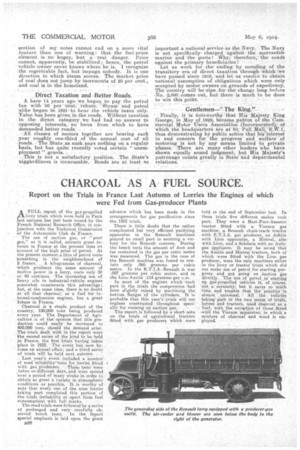CHARCOAL AS A FUEL SOURCE.
Page 14

If you've noticed an error in this article please click here to report it so we can fix it.
Report on the Trials in France Last Autumn of Lorries the Engines of which were Fed from Gas-producer Plants
IA.FULL report of the gaapropelled lorry trials which were held in Paris ast autumn has just been issued by the French National Research Office, in conjunction with the Technical. Commission of the Automobile Club de France.
The use of suction gas, or "poor gas," as it is called, attracts great in-. terest in France at the present time on 'account of the high price of petrol. At the present moment a litre of petrol costs eomething in the neighbourhood of 2 francs. A kilogramme of charcoal, 'which produces the same amount of Motive power in a Jerry, costs only 30 or' 40 centiines. The increasing use of heavy oils in-industrial-vehicle engines somewhat counteracts this advantage; but, at the same time, there is no doubt at all 'that charcoal; as a fuel for internal-combustion engines, has a great future in France.
Charcoal is a staple product of the country, 150,000 tons being produced every year. The Department of Agrivulture is of the opinionthat this productioncould easily be increased to 400,000 tons, should the demand arise. . The trials dealt with in the report were the second series of the kind to be held in France, the first trials having taken place in 1922. The event has now become an annual affair, and a third series of trials will be field nexl, autumn.
Last year's event included a numberof road reliability'tests for lorries fitted •
• •
with gas producers. Theie tests were :taken on different days, and were spread over a period of many -Weeks in order to obtain as great a variety in atmospheric' conditions as possible. It is worthy of note that every one of the nine lorries taking part completed this portion of the trials (reliability as apart from fuel consumption) with full marks.
The road trials were followed by a series of prolonged and very, carefully ob served bench tests. In the report special emphasis is laid upon the great E28 advance which 'has been made in the arrangements for gas purification since the 1922 trials.
There is little doubt that the rather -complicated but very efficient purifying apparatus in the Renault Machine's played no small part in securing a victory for the Renault concern. During the bench tests the amount of dust and tar contained in the gas per cubic metre was measured. The gas in the case of the Renault machine was found to contain only .066 gramme per cubic metre. . In the E.T.I.A.-Renault it was .087 gramme per cubic metre, and in the Lion-Austin .114 grarnme•Per c.m. In most of the engines which -took part in the trials the compression -had been slightly raised by machining the bottom flanges of the cylinders.: It is probable that this year's trials will see engines constructed throughout ipecially for running on suction gas. The report, is followed by ashort pole on the trials, of agricultural tractors fitted with gas producers which were
held at the end of September last. In these trials five different makes took part. They were a Hart-Parr-Amanco tractor fitted with a Yierzon gas machine, a Renault chain-track. tractor with E.T.I.A. gas producer, an Alfstin with Lion apparatus) a Mistral, also with Lion, and a Schemia with an Autogaz appliance. It may be noted that the Austin and Mistral tractors, both of which were fitted with the Lion gas producer, were the only machines either in the lorry or tractor trials which did not make use of petrol for starting purposes and gut going on action gas directly. -The use of petrol in starting
_ _ , .
tip gas-propelled vehicles e is, of course, -not a necessity; but it saves so much time. and tronble . that the -piaatice almost universal. All ; the vehicles taking part in the two series of triali, lorries and tractors, used charcoal as a fuel, with the exception bf those fitted .with the Vierzon -apparatus; in. which. a mixture of charcoal and wood is employed.


































